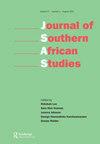The personal–local as national history
IF 0.7
4区 社会学
Q2 AREA STUDIES
引用次数: 0
Abstract
In Violence and Solace, Mxolisi Mchunu presents a highly moving, convincing account of violence and solace in South Africa’s KwaZulu-Natal province. Many readers will probably find the fact that the author was also affected personally during the pre-1994 violence in this south-eastern province of South Africa as the book’s biggest draw. The book presents a consistent historical account and identifies the landmarks of one of the most violent predemocracy episodes in KwaShange, an area that local media once dubbed ‘the killing fields’ of South Africa, one of the many rural villages that were adversely affected by the violence. Its storyline is a fascinating yet chilling account of South Africa’s pre-1994 civil war, which engulfed the country on the eve of its transition to democracy. The book’s method and approach consist of a rich array of case studies and interviewees’ narratives in 10 chapters. It presents the Natal’s civil war in late-apartheid South Africa, explaining the macro-politics of that time from a micro-political perspective. A comprehensive analysis of the causes, manifestations and devastating consequences of that civil war, it relies on extensive primary and secondary sources and a diverse literature review, including the publications of prominent African scholars and historians. This is one of the few doctoral studies in South Africa that has resulted successfully in a book. That it is written by an African student who witnessed first-hand much of what the book covers should appeal to readers. The author’s meticulous accounts of the origins, causes and nature of the political violence in KwaZulu-Natal also enhance the book. The book has an inviting cover (colour photograph) and includes a map and topographical sketch of the ‘Seven Days War’, outlined in the introductory chapter of the book (p. 71) and in Chapter 5, which present invaluable data of the carnage and deaths of that violent era. A further strength is the unique and passionate way in which the author narrates the story of his native KwaShange, which forms a case study for the book. There are, however, some limitations: those with a nervous disposition (or who are likely to find the photographs referred to above distasteful or disturbing) might find the book offensive or upsetting. This is not to criticise the author’s decision to present such photographs, as they strengthen the central argument of the book, which might not have been the case were these photographs omitted from its compelling account. These photographs serve as evidence of the carnage that the KwaShange villagers and other victims of the violence experienced. Yet the book might also be misconstrued to endorse the stereotype that South Africans, or the Zulu people, are violent, given that such violence remains a haunting spectre in the province and elsewhere in the country even today. The book’s autobiographical format in the tradition of historical scholarship outlines a consistent argument that will be welcomed by many readers of African history, politics and several other fields. It contributes to the burgeoning literature on nationalism in South Africa, whether Zulu, Afrikaner or British, which were at loggerheads at times during that period in South Africa.个人-地方和国家历史
在《暴力与慰藉》一书中,Mxolisi Mchunu对南非夸祖鲁-纳塔尔省的暴力与慰藉进行了非常感人、令人信服的描述。许多读者可能会发现,作者本人在1994年前南非东南部省份的暴力事件中也受到了影响,这是这本书最大的吸引力。这本书提供了一个一致的历史描述,并确定了夸瓦桑格(KwaShange)民主前最暴力事件之一的标志性事件。夸瓦桑格曾被当地媒体称为南非的“杀戮场”,是受暴力事件不利影响的众多农村之一。它的故事情节是对南非1994年之前内战的一个迷人而又令人不寒而栗的描述,这场内战在南非向民主过渡的前夕席卷了整个国家。本书的方法和方法由丰富的案例研究和受访者的叙述组成,分为10章。它呈现了种族隔离后期南非纳塔尔的内战,从微观政治的角度解释了当时的宏观政治。它全面分析了那次内战的起因、表现和破坏性后果,依靠广泛的第一手和第二手资料和各种文献审查,包括著名非洲学者和历史学家的出版物。这是南非为数不多的成功出书的博士研究之一。这本书的作者是一名非洲学生,他亲眼目睹了这本书的大部分内容,这一点应该会吸引读者。作者对夸祖鲁-纳塔尔省政治暴力的起源、原因和性质的细致描述也增强了本书的表现力。这本书有一个吸引人的封面(彩色照片),包括“七天战争”的地图和地形草图,在书的引言章节(第71页)和第5章中有概述,其中提供了关于那个暴力时代的大屠杀和死亡的宝贵数据。另一个优点是作者以独特而充满激情的方式讲述了他的家乡瓜桑格的故事,这是本书的一个案例研究。然而,也有一些限制:那些神经质的人(或者那些可能觉得上面提到的照片令人厌恶或不安的人)可能会觉得这本书令人反感或不安。这并不是批评作者决定展示这些照片,因为它们加强了本书的中心论点,如果这些照片从其令人信服的叙述中省略,情况可能就不会如此。这些照片是KwaShange村民和其他暴力受害者所经历的大屠杀的证据。然而,这本书也可能被误解为支持南非人或祖鲁人暴力的刻板印象,因为即使在今天,这种暴力在该省和该国其他地方仍然是一个挥之不去的幽灵。这本书采用了历史学术传统的自传体形式,概述了一个一致的论点,将受到许多非洲历史、政治和其他领域读者的欢迎。它促成了南非民族主义文学的蓬勃发展,无论是祖鲁人、阿非利卡人还是英国人,在那个时期的南非,这些民族主义有时是对立的。
本文章由计算机程序翻译,如有差异,请以英文原文为准。
求助全文
约1分钟内获得全文
求助全文
来源期刊

Journal of Southern African Studies
AREA STUDIES-
CiteScore
1.40
自引率
0.00%
发文量
73
期刊介绍:
The Journal of Southern African Studies is an international publication for work of high academic quality on issues of interest and concern in the region of Southern Africa. It aims at generating fresh scholarly enquiry and rigorous exposition in the many different disciplines of the social sciences and humanities, and periodically organises and supports conferences to this end, sometimes in the region. It seeks to encourage inter-disciplinary analysis, strong comparative perspectives and research that reflects new theoretical or methodological approaches. An active advisory board and an editor based in the region demonstrate our close ties with scholars there and our commitment to promoting research in the region.
 求助内容:
求助内容: 应助结果提醒方式:
应助结果提醒方式:


